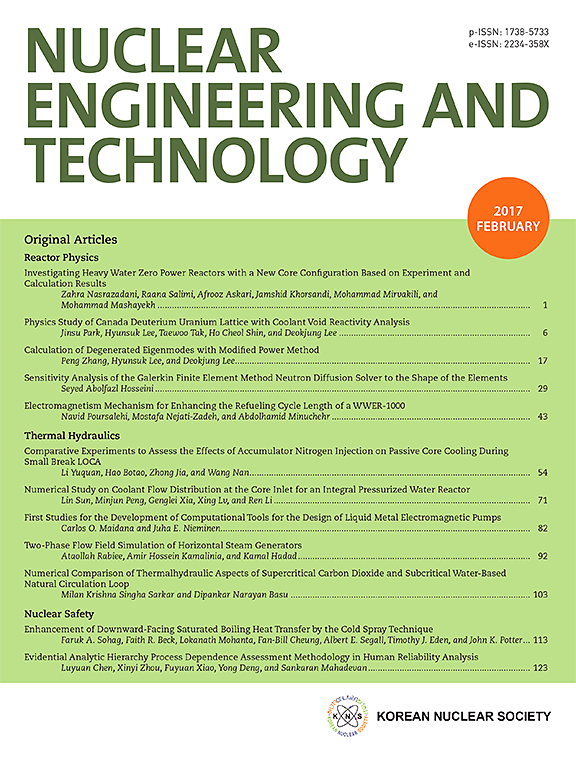加速器驱动亚临界系统中的核心功率控制策略
IF 2.6
3区 工程技术
Q1 NUCLEAR SCIENCE & TECHNOLOGY
引用次数: 0
摘要
本文报告了加速器驱动亚临界(ADS)系统中堆芯功率的控制策略。在 ADS 系统中,由质子加速器提供的高强度外部中子源耦合到溅射靶上,用于驱动亚临界反应堆。所提出的控制策略是通过调整质子束功率来控制反应堆功率,其中质子束功率是通过改变质子束的占空比或强度来调整的。以中国主动加速器驱动系统(CiADS)设施为例,研究了通过调整质子束功率来控制反应堆功率的问题。首先,通过分配一个新的占空比来粗略地设置质子束功率,其中占空比是通过改变质子束的宏观脉冲长度和脉冲重复率来设置的。脉冲长度和重复率均由定时系统分配。其次,通过改变光束强度来精确调节功率。为了连续改变束流强度,加速器中使用了一个可调光圈来阻挡束流线的外部粒子。为了评估所提出的控制策略,我们在多节点点反应堆动力学模型的基础上建立了 CiADS 核心模型。该模型模拟了设施启动、堆芯功率下降和堆芯功率上升三种情况。模拟结果表明,在设施运行期间,通过改变占空比或质子束强度来控制堆芯功率的策略效果非常好。本文章由计算机程序翻译,如有差异,请以英文原文为准。
Control strategy for the core power in an accelerator drive sub-critical system
This paper reports the control strategy for the core power in an accelerator drive sub-critical (ADS) system. In an ADS system, the intense external neutron source provided by a proton accelerator coupled to a spallation target is used to drive a sub-critical reactor. The proposed control strategy is to control the reactor power by adjusting the proton beam power, where the beam power is adjusted by changing either the duty factor or the intensity of the proton beam. As an example, the reactor power control of the China initiative Accelerator Driven System (CiADS) facility has been studied by adjusting the beam power. Firstly, the beam power is set roughly by assigning a new duty factor, where the duty factor is set by changing the beam macro-pulse length and the pulse repetition rate of the proton beam. Both the pulse length and the repetition rate are assigned by a timing system. Secondly, the power is adjusted precisely by changing the beam intensity. To change continuously the beam intensity, an adjustable aperture is used to block the outer particles of the beam line in the accelerator. In order to evaluate the proposed control strategy, a CiADS core model is built based on the multi-node point reactor dynamics model. Three cases, the start of the facility, the decrease of core power and the increase of core power, have been simulated with the model. The simulation results indicate that the control strategy for the core power by changing either the duty factor or the intensity of the proton beam works very well during the operation of the facility.
求助全文
通过发布文献求助,成功后即可免费获取论文全文。
去求助
来源期刊

Nuclear Engineering and Technology
工程技术-核科学技术
CiteScore
4.80
自引率
7.40%
发文量
431
审稿时长
3.5 months
期刊介绍:
Nuclear Engineering and Technology (NET), an international journal of the Korean Nuclear Society (KNS), publishes peer-reviewed papers on original research, ideas and developments in all areas of the field of nuclear science and technology. NET bimonthly publishes original articles, reviews, and technical notes. The journal is listed in the Science Citation Index Expanded (SCIE) of Thomson Reuters.
NET covers all fields for peaceful utilization of nuclear energy and radiation as follows:
1) Reactor Physics
2) Thermal Hydraulics
3) Nuclear Safety
4) Nuclear I&C
5) Nuclear Physics, Fusion, and Laser Technology
6) Nuclear Fuel Cycle and Radioactive Waste Management
7) Nuclear Fuel and Reactor Materials
8) Radiation Application
9) Radiation Protection
10) Nuclear Structural Analysis and Plant Management & Maintenance
11) Nuclear Policy, Economics, and Human Resource Development
 求助内容:
求助内容: 应助结果提醒方式:
应助结果提醒方式:


